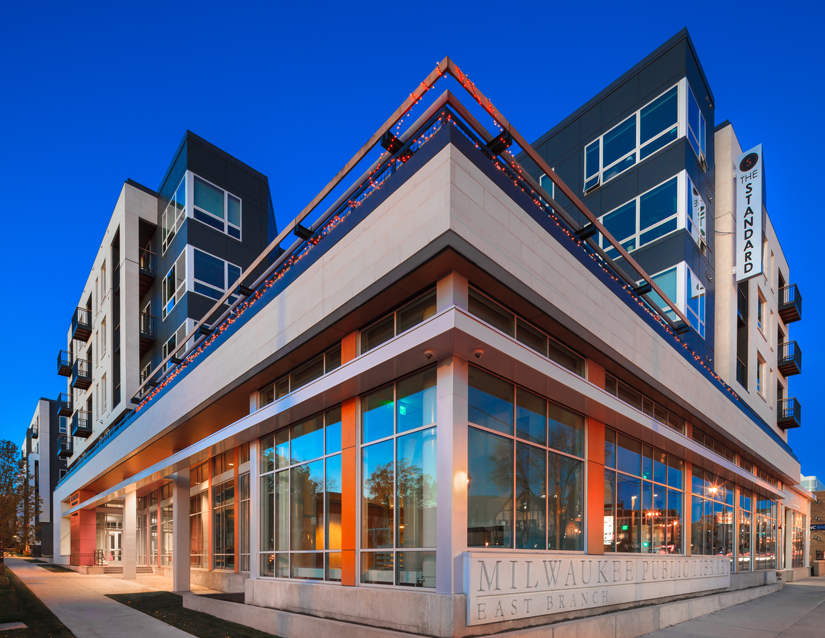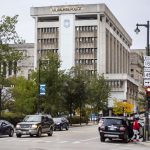The Impact of New Development
Study of 7 new buildings shows big revenue, big return for local government.
There’s no doubt Milwaukee is in the middle of a building boom. There are cranes on the skyline, construction cones at street level and trucks hauling materials every which way.
But what happens when the work is finished? Besides new residents moving in, besides the additional foot traffic, urban density and consumers of local restaurants and retail stores that are generated, all these new projects have a direct impact on the city’s bottom line, increasing the property tax base and spinning off added tax revenue.
To measure the impact of such development on the finances of local government, I conducted a survey of seven recently completed buildings in our growing buildings database. The net result? A collective annual property tax bill of $1,625,808.82. In aggregate that might look like a drop in the bucket compared to the total city property tax levy of $256.77 million, but when you look more closely at each project you start to see the huge impact on the city.
Take Sage on Jackson for example. A small apartment building that replaced an empty lot on the Lower East Side. A handful of neighbors opposed it, and local alderman Nik Kovac confessed that “I am in support of this project, although it is a close call,” during the project’s zoning hearing. It ultimately replaced a lot assessed at $55,300 with a building and lot assessed at $2.55 million, meaning the property value is now 46 times higher. Milwaukee Public Schools alone will receive in excess of $28,000 this year from that decision. That’s a lot of textbooks.
How about The Standard at East Library? The development that replaced the former East Library on E. North Ave. is a mixed-use development that includes a first-floor library. Previous tax revenue from that site? Zero, it was a government-owned lot. Tax revenue this year? $356,216.74. Should the city wish to use their share of the funds to purchase library books to fill the new library branch, they could purchase more than 12,000 copies of Fifty Shades of Grey from Amazon.
True, new development alone won’t restore sagging local government budgets still recovering from the massive impact of the Great Recession and the foreclosure crisis. But the city, county, schools and other local property taxing bodies would be in a world of hurt without new development.
All of which underlines the need to structure sound public policy through zoning and other regulations that makes it as easy as possible to generate more new construction. If not-in-my-backyard (NIMBY) opposition makes proposed buildings shorter, smaller or prevents projects altogether, the end result can easily be thousands of dollars going to other municipalities annually as developers seek the path of least resistance.
Before digging into my building-by-building breakdown, a few quick notes.
- The City Tax here represents the tax collected for Milwaukee Public Schools, Milwaukee Metropolitan Sewerage District, Milwaukee Area Technical College, and the City of Milwaukee. MPS and the city receive the bulk of this, see the full breakdown on the assessor’s website.
- County Tax represents the property tax collected by Milwaukee County and a small amount by the State of Wisconsin.
- I dropped all special assessments and credits, although they’re reflected in the total tax bill. Sidewalk repairs, lottery tax credits, are all visible if you follow the link to the Total Property Tax Bill.
- The previous Assessed Value year (often 2011) represents the year before the new development started, for which there are records available. For a development like Dwell, which included the combination of a number of taxkeys, such records are sometimes not easily available.
Dwell Bay View
What was it before? A largely underutilized lot on Bay View’s main street, S. Kinnickinnic Ave., as well as a couple smaller dwellings.
What is it now? Dwell is a mixed-use apartment building with 70 units, 85 parking spaces and first-floor retail (occupied by Snap Fitness, Community Bark, Rocket Baby Bakery and an insurance agent).
- Assessed Value 2015: $7,876,000 (Land: $210,000, Improvements: $7,666,000)
- Assessed Value 2012: $900,000 (Land: $210,000, Improvements: $690,000)
- Total Property Tax Bill: $232,915.43
- City Tax: $178,150.08
- County Tax: $53,065.66
IVY on Fourteenth
What was it before? A strip mall.
What is it now? A mixed-use apartment building targeted at Marquette University students with 80 units and first-floor retail space.
- Assessed Value 2015: $13,030,000 (Land: $88,000, Improvements: $12,942,000)
- Assessed Value 2011: $664,000 (Land: $569,700, Improvements: $94,300)
- Total Property Tax Bill: $382,871.08
- City Tax: $294,730.27
- County Tax: $87,791.44
RowHouse 31
What was it before? A parking lot and home converted into a child care facility.
What is it now? Four buildings containing 31 townhouse-style apartments.
- Assessed Value 2015: $4,730,000 (Land: $186,000, Improvements: $4,544,000)
- Assessed Value 2011: $398,000 (Land: $116,300, Improvements: $281,700)
- Total Property Tax Bill: $138,777.52
- City Tax: $106,989.57
- County Tax: $31,869.04
Sage on Jackson
What was it before? An empty lot.
What is it now? A five-story, LEED-Platinum apartment building containing 20 rental units.
- Assessed Value 2015: $2,552,000 (Land: $192,000, Improvements: $2,360,000)
- Assessed Value 2011: $55,300 (Land: $55,300, Improvements: $0)
- Total Property Tax Bill: $75,510.63
- City Tax: $57,724.61
- County Tax: $17,194.45
The Standard at East Library
What was it before? The one-story East Library branch of the Milwaukee Public Library.
What is it now? A five-story, 99-apartment mixed-use building that includes one commercial space and a 16,000 square-foot condominium containing the new East Library.
- Assessed Value 2015: $12,109,000 (Land: $1,048,900, Improvements: $11,060,100)
- Assessed Value 2011: $0 (Tax Exempt)
- Total Property Tax Bill: $356,216.74
- City Tax: $273,897.83
- County Tax: $81,586.09
Pabst Professional Center
What was it before? An empty lot following the demolition of electrical facilities from the former Pabst Brewery.
What is it today? A 71,220 square-foot office building.
- Assessed Value 2015: $4,375,000 (Land: $342,900, Improvements: $4,032,100)
- Assessed Value 2011: $190,500 (Land: $190,500, Improvements: $0)
- Total Property Tax Bill: $137,930.92
- City Tax: $98,959.71
- County Tax: $29,477.18
Two50Two
What was it before? A one-story, commercial building.
What is it now? A 75-unit (310 beds) apartment building targeted at Milwaukee Institute of Art & Design students with first-floor commercial space.
- Assessed Value 2015: $9,693,000 (Land: $553,00, Improvements: $9,140,000)
- Assessed Value 2011: $1,895,000 (Land: $984,800, Improvements: $910,200)
- Total Property Tax Bill: $301,586.50
- City Tax: $219,249.46
- County Tax: $65,307.94
Eyes on Milwaukee
-
Church, Cupid Partner On Affordable Housing
 Dec 4th, 2023 by Jeramey Jannene
Dec 4th, 2023 by Jeramey Jannene
-
Downtown Building Sells For Nearly Twice Its Assessed Value
 Nov 12th, 2023 by Jeramey Jannene
Nov 12th, 2023 by Jeramey Jannene
-
Immigration Office Moving To 310W Building
 Oct 25th, 2023 by Jeramey Jannene
Oct 25th, 2023 by Jeramey Jannene


















While I, too, love all the development in Milwaukee, note that it has little actual benefit to the public schools. MPS’s revenue authority is limited by the state legislature, so no matter how much additional development there is, unless it draws new students to the district it will not increase MPS’s budget.
It does have the effect of decreasing other taxpayers’ share of the bill for MPS, and has an effect on how much state aid comes in versus local tax revenue, but the end result–the overall size of the MPS budget–doesn’t change. I wrote about this during the streetcar debate.
http://onmilwaukee.com/buzz/articles/streetcarandmps.html
Jay,
A good point but it is worth remembering that that is true only when the school board is using the full funding limit. Usually it does but i recall two times when some of the cap went unused. An increased tax base makes using the funding limit more politically palatable.
Since we have development fever in the city’s hotspots, I wonder what the impact of similar development would be in the central city where there are blocks of foreclosed houses? Just wondering.
Paula,
Developments like this are not feasible in the central city right now. Developers need to see a return on their investment and why would they take the risk of building on Fond du Lac Ave. when they have a sure bet in Walker’s Point or the Eastside? That is the great catch 22, the area’s that desperately need private investment are the one’s that don’t receive any because it is seen as risky or low returns. And so the downward spiral continues.
That is why Milwaukee need’s to gentrify! I know the dirty word, but what is gentrification really other than private investment flowing back into neighborhood’s that generally desperately need it? As the hot spots become more expensive some residents get priced out, they then move out a little bit to more marginal areas and begin to improve them and the cycle continues. Its happening in Chicago and it is the only mechanism I know of that will turn around the central city. But it will take another decade or two for that to all play out in MKE. In the meantime, the city and non-profits will need to continue to do what they can to stablilize these areas to prevent them from decaying anymore and wait for the private investment wave to work it’s way out to them.
@Paula
Thanks for the comment. That’s a whole issue I hope to tackle at some point in the future. Clearly there is a huge impact when a foreclosed, empty home is put back into the hands of a homeowner (or even a renter without a slumlord as landlord). Reduced policing needs, better neighborhood, more investments in the neighborhood (the keeping up with the Jones’ effect) and ultimately more tax revenue for the city.
It was beyond the scope of this article, but is in no way less important to a healthy city.
-Jeramey-
Great job Milwaukee, but we also must do something about the crime in our inner city and help support organization like http://www.clubkids414.org open a community theater and help #StopTheViolence
Donate a building or funds for our current location sore can remodel the space and help at-risk kids.
MPS is an unmitigated disaster. All this tax money spent on MPS and you can’t even send your kids to MPS. The taxes on the east side keep going up and the taxes to the west keep going down:
http://www.jsonline.com/watchdog/watchdogreports/compare-property-values-milwaukee-county-surrounding-areas-277901981.html#!/milwaukee-county/city-of-milwaukee/
MPS needs to be broken up into community districts where the community schools are funded by the local community. Aldermanic district 3 should be like a Shorewood south community with schools that are as good or better than the Shorewood schools. Having to pay high taxes to MPS, get nothing for it, and have to pay again to send your kids to private school needs to stop. It is the reason that the city is not reaching its full potential as families can’t move to the city.
Erik what would you use as a model for MPS? What other district of a comparable size has successfully implemented a community district model?
Vincent:
The population of the east side of Milwaukee is comparable to the population of Shorewood, Whitefish Bay, or Greendale. Look at the percentage of children on the lower east side compared to the other communities:
http://statisticalatlas.com/neighborhood/Wisconsin/Milwaukee/Lower-East-Side/Age-and-Sex
http://statisticalatlas.com/neighborhood/Wisconsin/Milwaukee/Upper-East-Side/Age-and-Sex
http://statisticalatlas.com/place/Wisconsin/Shorewood/Age-and-Sex
http://statisticalatlas.com/place/Wisconsin/Whitefish-Bay/Age-and-Sex
http://statisticalatlas.com/place/Wisconsin/Greendale/Age-and-Sex
I want to see the east side of Milwaukee operated like an independent community. I want to see the school system on the east side be as good or better than Shorewood, Whitefish Bay, or Greendale so that more families would have the option to move to the city. As it is now if you want you kid to attend a decent public school in the Milwaukee area you need to move to one of the surrounding communities to get away from MPS or try and get in with open enrollment and then pay twice, once in your property taxes for MPS and again for the open enrollment school.
So, Erik, what you’re saying is, you want a segregated upper-class white school district/city-within-a-city on Milwaukee’s East Side and the poorer, blacker, browner parts of town can … suck it? die in a fire? what?
I have this debate a lot with my neighbors here in Bay View. If “those kids” weren’t at BVHS, they say, it would be great! “Those kids” are my students, though, and I can’t stand the implication–it embarrass me to be a white man in a city with so many outright segregationists. Wow.
Jay:
I didn’t say that. MPS is a complete and utter failure. It is a national disgrace, http://www.jsonline.com/news/education/arne-duncan-on-milwaukees-chronic-woes-a-national-disgrace-b99656481z1-366329791.html. I think the topic deserves a discussion on how to fix it.
Why are you such a strong supporter or MPS? I understand you work there and want to keep the status quo. What advantages are we getting from having this large central bureaucracy? Your solution is to have one massive federal school system and anything less is overtly racist? My argument is to break up the school system into manageable community school districts supported by the local tax base. Yes, Bay View should have it’s own local school system. Something needs to be done. As it is now, families can’t move to the city. If you have a kid you need to move out of the city. Companies can’t move to the city because its workforce can’t live in the city. Yet we keep dumping our tax money into the rat hole that is MPS and hoping that it will just magically fix itself while being incentivized to keep everything the same.
Erik so all you care about is the schools on the east side? I thought you were talking about all of MPS? Is there a model you can point to that would work for MPS, or are you just guessing that the community district model would work?
I don’t know what else you think we should call it when someone argues for walling off a neighborhood from the rest of the city based on that neighborhood’s demographic similarity to historically white-flight inner- and middle-ring suburbs.
MPS is hardly a “complete utter failure.” Depending on who’s ranking and how, MPS schools regularly occupy three or four of the slots in “top ten” lists of Wisconsin schools. Even in (what you might call) the craphole where I teach, I just had a student win an $80,000 scholarship to a selective Wisconsin private college. I have never been more proud to do what I do.
So, sure, I teach for MPS, and that may bias me. But I’ve also been writing about education policy, in MPS and Wisconsin specifically, for almost two decades. This is my wheelhouse. So trust me when I say this: Neither the East Side nor Bay View can sustain a quality public school system.
What advantage does MPS as a whole have? Besides being a large consumer–saving money in everything from bulk purchases of textbooks and technology to negotiations with insurance companies for health care–MPS as a whole can take advantage of the entire city’s tax base. Downtown Milwaukee holds virtually no school-aged children in its taxable parcels, but it provides a tremendous share of MPS’s local tax revenue. Without it, the system as a whole, and certainly any splinter district, would fail. (This leaves aside more complex issues like MPS’s future debt and bond obligations that would undoubtedly mean bankruptcy for what’s left behind if you split off certain parts.)
Plus, neither the East Side nor Bay View has enough school-aged children to fill its buildings; the demographics, besides being whiter and wealthier than the city as a whole, are also skewed to the young and childless and old and empty-nested in a way you don’t see elsewhere in the city. Here in Bay View, for example, almost every school in the neighborhood (depending on where you draw the boundaries) draws more students from outside the neighborhood than in. If the high school kicked out every student who didn’t live in 53207, the halls would be nearly empty. Even if we brought back all the 53207 teenagers going to Reagan, King, Arts, St. Francis, etc., the high school would lose a third of its enrollment. It wouldn’t be able to field a football team or a decent band. It wouldn’t be able to sustain its STEM program. And so on. The same is true for Riverside High School–its enrollment is mostly non-East Side kids, and if you did get those East Side kids back from Rufus King and its IB program, you’d have a half-empty Riverside and a massive parent revolt on your hands.
And even if this magically did draw people back to the city–or, rather, your special white enclaves–where would these families with children live? Not in Mandel’s new tower or the “micro-apartment” monstrosity they’re building on the on Faust Music site.
But most importantly–yes, I do have a point!–I feel that as a Milwaukeean, I have an obligation to my city, to its fugly flag and its dumb di Suvero. And to its children, all of them. If we can help those who need it, we must. That’s a simple moral imperative it would be foolish not to follow.
http://onmilwaukee.com/family/articles/resourcegaprevisited.html
I have long been a proponent of breaking up MPS into separate community based school districts. Yes, there are people who just want to keep their children away from the influence of “those kids” and not worry about the decaying parts of the city that segregation and racism created. However, I think that is just a side effect of the greater things that can be accomplished. If Erik and others actually keep their families in Milwaukee (or move into MKE in the first place), then fine so be it, let’s take their property tax payments and hopefully well-adjusted children and add them to the pot. At least that’ll increase the overall property value of the city.
Meanwhile, we can see many advantages to the community schools. First, reagardless of the affluent whitey areas or poor minority hoods, it’s shown that if there is a buy-in and ownership in the schools then children tend to do better. That sense of community goes a long way. Second, you eliminate the shell game and anxiety of trying to get your kids into the few good schools. I for one will move out of Milwaukee as soon as my children are school age, and this is a big factor. I want to know my kids are going to the school down the street and that they’ll matriculate with their peers into the same secondary schools. Knowing what their future is has a strong positive effect as well.
Finally, by breaking up MPS into smaller districts we’ll no longer need to use a shotgun effect to send resources for special challenges all across the system. Part of the agreement will need to include a funding mechanism to make sure we have more counselors, smaller classes, special education resources, family and social resources, and yes even security resources at the fewer schools that need them. Frankly, I can’t imagine even the worst of the “new districts” can be any worse than many of the schools that already exist in MPS. Now, we can finally focus resources on those areas.
Not all of my opinions are PC, but if we keep pretending like there aren’t areas of Milwaukee that would probably, by default of socioeconomic factors, improve almost automatically… then we’re just perpetuating a system that keeps the whole district down.
Just to clarify, I recognize there would be some inherent predominant demographics in various community school districts, my hope would be they could find a way to ensure at some level there is an integration as much as possible. The 53222 and 53225 zip codes would probably be a great example. While one is majority white and another majority black, they have fairly similar socio-economic factors that would probably create a pretty solid district in many ways.
Has a district the size of Milwaukee ever tried the community-based school district model? It seems like one of those things that people can make sound great but in reality is much more difficult and problematic than it seems.